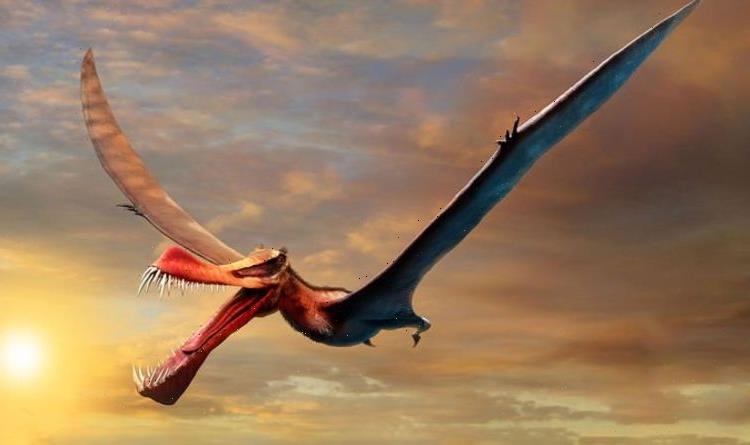University of Queensland scientist on ‘exciting’ dinosaur find
We use your sign-up to provide content in ways you’ve consented to and to improve our understanding of you. This may include adverts from us and 3rd parties based on our understanding. You can unsubscribe at any time. More info
The newly named Thapunngaka shawi is the biggest flying reptile ever discovered in the Land Down Under. With a wingspan measuring an impressive 22ft (7m) and with rows of 40 razor-sharp teeth, researchers believe this is the closest palaeontologists will ever come to finding a real-life dragon. The prehistoric pterosaur would have soared through the skies above a vast inland sea once covering outback Australia.
The pterosaur’s fossilised jaw was discovered by local Len Shaw in a quarry in Wanamara Country, near Richmond in North West Queensland, in June 2011.
The fossil was then analysed by PhD candidate Tim Richards, from the Dinosaur Lab at the University of Queensland.
The palaeontologist said: “It’s the closest thing we have to a real-life dragon.
“The new pterosaur, which we named Thapunngaka shawi, would have been a fearsome beast, with a spear-like mouth and a wingspan around seven metres.


“It was essentially just a skull with a long neck, bolted on a pair of long wings.
“This thing would have been quite savage.
“It would have cast a great shadow over some quivering little dinosaurs who wouldn’t have heard them coming until it was too late.”
The skull on its own would have measured more than three feet (one metre) – and it was the perfect tool for plucking large fish from the long-gone Eromanga Sea.
Although sometimes called the flying dinosaurs, pterosaurs were a distant relation to dinos.
This fearsome group of winged reptiles included the likes of the famous Pterodactyl.
Pterosaurs: Expert discusses anatomy of extinct reptile
Because they flew and their front limbs stretched out on their sides, scientists do not classify pterosaurs as birds, dinos or even flying mammals.
Pterosaurs have the distinction of being some of the first animals to evolve the ability to fly.
But according to Mr Richards, they were nothing like the bats or birds of today.
He said: “Pterosaurs were a successful and diverse group of reptiles – the very first back-boned animals to take a stab at powered flight.”
The newly discovered Thapunngaka shawi belonged to a family of pterosaurs known as the anhanguerians.


Anhanguerians inhabited virtually every continent during the latter days of the Age of Dinosaurs – between 245 and 66 million years ago.
The winged beasts were well adapted to fly with relatively hollow bones and thin skin stretched between the bones of their front limbs.
But this also means their bones rarely appear in the fossil record.
What makes the Thapunngaka shawi stand out from the crowd is the massive, bony crest at the bottom and likely at the top of its jaw.
Dr Steve Salisbury, a co-author on the paper and Mr Richard’s PhD supervisor, said: “These crests probably played a role in the flight dynamics of these creatures, and hopefully future research will deliver more definitive answers.”
The name Thapunngaka shawi was chosen to honour the First Nations people of the Richmond area, by selecting words from the now-extinct language of the Wanamara Nation.
The word “thapunngaka” incorporates the words “thapun” and “ngaka”, which mean “spear” and “mouth” respectively.
Dr Salisbury said: “The species name, ‘shaw’, honours the fossil’s discoverer Len Shaw, so the name means ‘Shaw’s spear mouth’.”
The fossil is now on display at the Kronosaurus Korner museum in Richmond, Australia’s “premier marine fossil museum”.
Source: Read Full Article
